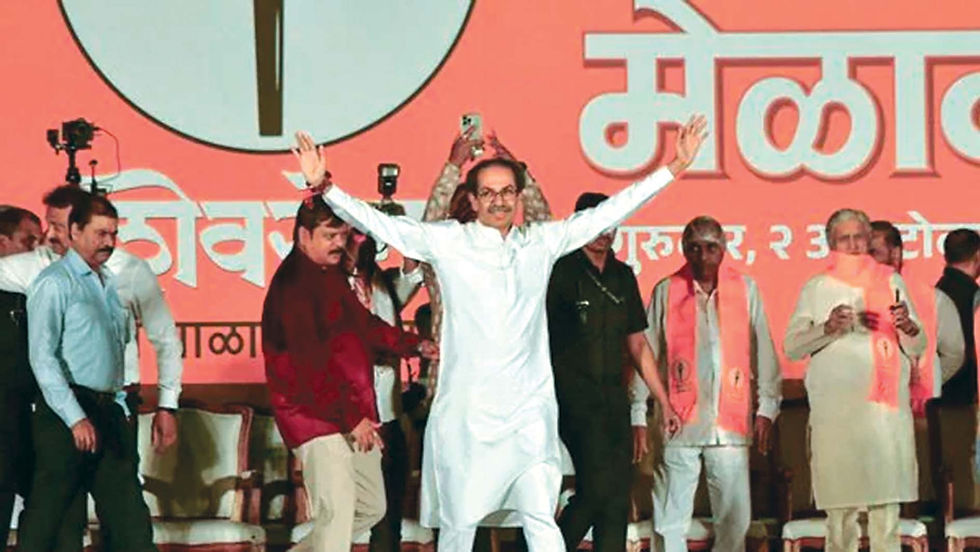Rites of Power
- Abhijit Joshi

- Oct 3
- 4 min read
Maharashtra’s Dussehra rallies reveal that ideology, legacy and governance are potent weapons in the state’s upcoming civic elections.

In Maharashtra, Dussehra has long been less a festival than a theatre of politics. For decades, the state’s political calendar turned on two very different kinds of oratory. In Mumbai, Balasaheb Thackeray’s speeches at Shivaji Park were flamboyant and fiery where the Congress and minorities alike were frequent targets. Balasaheb’s words reverberated in homes, chai shops and political corridors for weeks. Meanwhile, the Rashtriya Swayamsevak Sangh’s (RSS) Vijayadashami gatherings in Nagpur were quiet, methodical and ideological, with little immediate spectacle but tremendous long-term impact. The Sangh, historically reticent about limelight, only became a central actor in national politics after the Bharatiya Janata Party (BJP) consolidated power in 2014. Since then, the Sarsanghchalak’s annual address has been scrutinised as a lodestar for the Sangh Parivar.
Multiple gatherings
With Balasaheb’s passing, Uddhav Thackeray inherited a legacy he struggled to preserve. Yet the political landscape has changed. The Shiv Sena has split, the RSS has grown more visible, and Maharashtra’s Dussehra rallies have multiplied. They are no longer confined to a single symbolic stage. The RSS, the Shiv Sena faction led by Chief Minister Eknath Shinde, and Uddhav Thackeray’s Shiv Sena (UBT) each now organise their own gatherings. These events are instruments of messaging, strategy and electoral preparation. This year, each carried weight not just for symbolism but for what they revealed about upcoming municipal and panchayat elections.
In Nagpur, the RSS marked its centenary year with its traditional Vijayadashami Sabha. Sarsanghchalak Mohan Bhagwat delivered his address with calm authority, eschewing direct political attacks while sketching an ideological roadmap. He spoke of economic growth, inequality, environmental fragility and India’s civilisational role. The global development model, he warned, was unsustainable with wealth concentrated in the hands of a few and ecological destruction unchecked. India, Bhagwat argued, must pursue self-reliance as a conscious civilisational choice. Climate irregularities, melting glaciers, and the vulnerability of the Himalayas were cited as urgent concerns.
Bhagwat also offered pointed lessons from abroad. He said that evolutions in Sri Lanka and Bangladesh that bypassed democratic processes had resulted only in instability. He outlined five areas for swayamsevaks: social equality, family awakening, environmental protection, swadeshi, and adherence to law and discipline. For the BJP and its allies, the message served as a subtle anchor, reminding candidates that campaigns must align with broader cultural and social narratives even while addressing local grievances.
Uncompromising rhetoric
In Mumbai, the Dussehra stage was contested with a very different energy. Deputy Chief Minister Eknath Shinde’s rally at Goregaon’s NESCO grounds radiated confidence and confrontation. His targets were clear: Uddhav Thackeray and the UBT. Shinde denounced Uddhav as a “conspiracy chief” and claimed that after the local elections “even Uddhav Thackeray’s shadow will not follow him.” The rhetoric was uncompromising: this was a bid to position Shinde’s faction, bolstered by the BJP and Mahayuti allies, as the dominant political force in civic affairs.
Yet, Shinde also sought to project governance credentials. He contrasted his hands-on approach with what he portrayed as Uddhav’s detachment, highlighting personal involvement in flood relief, promises of financial aid, housing, and protection of Marathi interests. The message was clear: leadership is not just about ideology but delivery. By framing the contest as governance versus betrayal, Shinde aimed to consolidate urban Marathi voters while casting himself as a credible administrator.
Uddhav Thackeray’s rally at Shivaji Park was markedly different. His tone was reflective, nostalgic, yet defiant. He compared the BJP to an “amoeba,” a metaphor for opportunistic, shapeless expansion, and warned against attempts to “steal votes” or fragment the Sena. The harshest criticism was reserved for defectors, whom he labelled “brass” in contrast to loyal cadres of “gold.” His speech intertwined legacy, civil liberties and democratic freedoms, positioning UBT not merely as a survivor of party splits but as a custodian of pluralism and rights.
Uddhav’s approach seeks to appeal simultaneously to Marathi sentiment and liberal-moderate voters wary of centralisation. But speeches alone may not translate into electoral success. Maharashtra’s local elections are decided not in grand halls but on granular issues: water supply, sanitation, housing, and flood mitigation. Without robust ground-level mobilisation and delivery-oriented messaging, UBT risks being outpaced by Shinde’s organisational strength and the disciplined machinery of the RSS-BJP nexus.
Together, the three rallies illuminate the contours of the state’s municipal and panchayat battles. The RSS, while not contesting directly, provides ideological direction and ensures cadre discipline. Shinde’s faction, wielding administrative resources, seeks to dominate civic polls and claim authenticity to Balasaheb’s vision. Uddhav, weakened by defections but buoyed by loyalty, fights to preserve relevance through a dual strategy of legacy and democratic advocacy.
For voters, the calculus is practical as well as symbolic. Who will unclog drains before the next monsoon? Who will ensure waste is collected efficiently? Who can deliver housing for slum dwellers or run municipal schools effectively? In rural panchayats, caste equations, agriculture, and local patronage may matter more than ideology.
Both Sena factions face the danger of splitting the Marathi vote. Shinde urges consolidation under his leadership; Uddhav warns against ceding ground to the BJP. In local elections, even marginal vote diversions can flip outcomes in closely contested wards, particularly in Mumbai’s BMC, where stakes are both financial and symbolic. With RSS influence ensuring disciplined campaigning by the BJP, UBT’s fortunes hinge on credible alliances and presenting itself as a viable alternative.
The verdict, however, will not be delivered on the podiums of Reshimbagh or Shivaji Park. It will emerge, painstakingly and incrementally, from thousands of polling booths across Maharashtra’s cities and villages. Dussehra has set the stage; the electoral battlefield now awaits.
(The writer is a political observer. Views personal.)





Comments